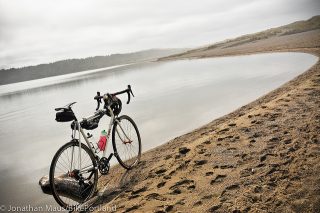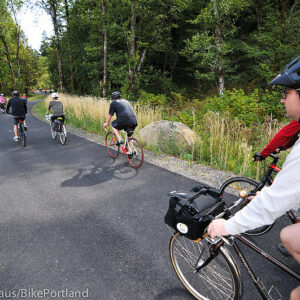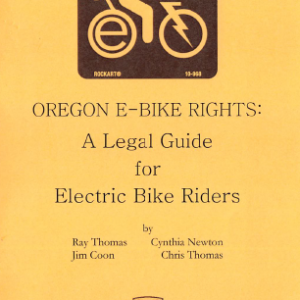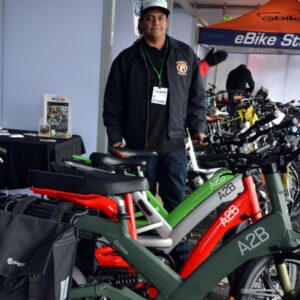Last summer we threw a bit of cold water on the very hot trend of electric-assisted bicycles when we reported on the little-known fact that e-bikes were prohibited on paths and trails managed by the Oregon Parks and Recreation Department (OPRD).
At the time, OPRD acknowledged that they never intended to exclude e-bike riders from popular paths like the Historic Columbia River Highway and Banks-Vernonia Trail. The situation, they felt, was a matter of the law not keeping up with the times. Oregon’s vehicle code recognizes e-bikes as bicycles; but OPRD facilities are managed with Oregon Administrative Rules (OAR) which didn’t mention e-bikes at all. This meant they fell into the category of “motor vehicles” and were managed as such.
In response to public pressure to address the issue, OPRD began the process to amend their rules last September. Today we confirmed with agency staff that the State Parks Commission has approved a rule change that explicitly allows electric-assisted bicycles on all paths and trails eight-feet and wider unless otherwise posted.
The approval means that OAR 736-010-0015 now includes a statutory definition for “electric assisted bicycle” that is a carbon copy of Oregon Revised Statute 801.258.
More significant changes and amendments have been made to OAR 736-010-0026, the rule that governs the use of bicycles and other “similar devices” on OPRD facilities. The title of the rule has been changed from, “Non-Motorized Vehicles, Cycles or Similar Devices,” to “Operator-Propelled Vehicles, Cycles or Similar Devices.”
And the major addition is subsections (3) and (4):
(3) A person may operate an electric assisted bicycle on roads and trails eight feet or wider unless otherwise posted to restrict or permit such activity.
(4) The director or designee may open or close roads and trails to the operation of non-motorized cycles, electric assisted bicycles or similar devices, based on an evaluation of factors related to the use of these devices including, but not limited to, the degree of conflict with other users, public safety, or damage to park resources.
The rule was written in a way that allows individual park managers to allow e-bikes on narrower trails if and when appropriate.
OPRD also proposed to amend the rules to that e-bikes could be used on the ocean shore in all places where standard, non-motorized bicycles are currently allowed. The commission did not approve that proposal and instead chose to allow e-bikes only on sections of the coast where people are currently allowed to drive cars and trucks.
At their June 13th meeting Parks Commissioners heard a report from OPRD staff on how the public reacted to the proposals. OPRD received 332 comments with 201 people “generally opposed” to any rule changes and 127 people in support of more e-bike access on trails. Here’s a summary of the public feedback (taken from the meeting packet):
201 commenters were generally opposed to a rule change. Of those75 specifically were opposed to increasing use of electric bicycles on the beach.
56 commenters identified as equestrians concerned about increased user conflict with additional bicycles on trails.
There were 127 comments in support of adding electric bicycles to trails and/or the ocean shore. Commenters often described how electric bicycle allow them to continue to enjoy riding bicycles after an injury or illness.
In general, those opposed to the rule change expressed concern over safety, user conflict and lack of enforcement. Those in support generally feel electric bicycles should be seen as any other bicycle and would like to see OPRD regulate behavior, not the type of bicycle a person chooses to ride.
Themes of the comments:
• Numerous equestrian riders expressed concern over safety on our trails. They described fear over the encounters with bicycles currently and did not want to see additional users on already
crowded trails. Specifically, the often cited fears of a quiet e-bike coming up behind them at a fast rate of speed and spooking their horse.• Many Oregonians were concerned with the peace and tranquility of the beach being disrupted by fast moving electric bicycles on the beach. They were concerned about the safety for kids and dogs if bicycles were riding fast. There were also a number of people concerned about the habitat impacts on the beach if more bicycles were riding faster and further. A number of people said they were comfortable with electric bicycles on motorized sections of the beach, but did not want
to see that expanded to all sections of the beach.• Many of the commenters in support of electric bicycles describe themselves as part of the baby boomer generation. They describe how as they have aged the move to an electric bicycle as allowed them to keep active. Some describe how the electric bicycle gives them the opportunity to keep up with younger family members or see new areas of the state.
• Commenters expressed concern over lack of enforcement. Commenters expressed concern over whether OPRD had the staffing to enforce types of equipment covered under the definition or limits on speed and other safety requirements included in the rules.
• We received many comments from the Hood River area where electric bicycle riders would like to ride along the Historic Columbia River Highway State Trail and enjoy the scenery.
• There were a number of comments expressing concern over whether a move toward acceptance of electric bicycles was a slippery slope toward allowing additional electric or gas powered devices on trails or the beach.
The rule is currently in effect and new signage is expected to start showing up in State Parks and other facilities by October.
— Jonathan Maus: (503) 706-8804, @jonathan_maus on Twitter and jonathan@bikeportland.org
Never miss a story. Sign-up for the daily BP Headlines email.
BikePortland needs your support.









Thanks for reading.
BikePortland has served this community with independent community journalism since 2005. We rely on subscriptions from readers like you to survive. Your financial support is vital in keeping this valuable resource alive and well.
Please subscribe today to strengthen and expand our work.
I think e-bikes and e-scooters, etc are ultimately good for bike infrastructure in the long term. It will ultimately create a more inclusive network with a larger, more diverse set of stakeholders clamoring for improvements. However, in the short term, the already crowded, under built and disjointed infrastructure will become even more strained until the powers that be see the light. As a cyclist, I do not expect this to affect me very much in the short-term (I already avaoid the esplanade all summer, etc). However, I greatly sympathize with the walkers, equestrians and especially families who are trying to enjoy a safe, quiet recreation area like the springwater trail or the esplanade. In many ways, cyclists had already dominated those spaces and them very difficult and unsafe to use with kids. Adding e-travelers will make this worse by adding more visitors and higher speed visitors. I hope that PP&R and PBOT will see the writing on the wall and make some significant investments in expanding, upgrading and completing our tepid network, but they have been a reactive mode for the last couple of decades.
I think the main benefit of cycling has been lost in translation as we have attempted to funnel them into tiny segregated spaces. The primary reason I embrace e-bikes is that they will force traffic planners, traffic engineers and cycling advocates to acknowledge that bicycles are appropriate replacements for cars and cannot be confined to sidewalk-like corrals.
It’s also no more appropriate to design infrastructure in such a way that cyclists who ride over 20 mph are at risk than it is to design roadways in which motorists are put at risk if they drive such a speed.
Now if only the state of Oregon would show the same enthusiasm for e-bikes as it has shown for e-cars, we’d finally start making some dents in our most serious issues (rapidly rising roadway deaths, climate change, public health catastrophes from sedentary lifestyles and much more).
Agreed. Any of the e-bikes described here, including the over-powered fat tired bikes that could not possibly be effectively pedaled, are more like bikes than like cars. In gross weight, in power-to-weight ratio, in hazard to the operator in the event of a crash, they are still approximately in the realm of bikes and on the street they are still largely playing by bike rules. Their presence on the street affects larger motor vehicles, cars and trucks, in about the same way that acoustic bikes do. (I like that, acoustic bikes! Except it’s more of a dance thing than a music thing.)
E-bikes create demand for bike space and they cause MV operators to be more aware of bikes. MV operators have a moral hazard of near-invulnerability. E-bike operators riding in the chippy way that some of them do pushes back on what might be called car privilege.
Nowhere up there does it say that overpowered e-bikes aren’t annoying and kind of a danger to their operators and to others.
The speed differential between e-bikes and the other users of those trails is a problem that will only get worse.
I was on Vancouver St today, behind an e-biker who was cruising at 28 mph with very little effort. If the rider had wanted to pedal harder, he could have been going well over 30 mph. They can go fast up a grade as well as on the flat. E-bikes are becoming more powerful. We will essentially have electric scooters in the bike lanes and on the trails.
This.
The line is becoming more and more blurred until we cant find our way back.
That is not any typical e-bike going that fast without effort. I can’t even get my e- bike up to 28 mph without both going downhill and pedaling. I ride with my wife primarily. She trains for triathalons ( no assist) and I work to keep up with her. I don’t think the speed differential is as big as you think.
Sadly, this is where enforcement of codes needs to happen. I am pretty sure that an ebike capable of travelling that speed is not “allowed” to us the bike lane.
Oregon State Law
At the state level, e-bikes are touched on by the Oregon Revised Statutes (ORS) in several places. First, state law clearly says that e-bikes are legally considered to be bikes:
814.405 – Status of electric assisted bicycle
An electric assisted bicycle shall be considered a bicycle, rather than a motor vehicle, for purposes of the Oregon Vehicle Code, except when otherwise specifically provided by statute.
And here’s the Oregon Department of Transportation’s (ODOT) definition of an e-bike:
801.258 “Electric assisted bicycle” means a vehicle that:
(1) Is designed to be operated on the ground on wheels;
(2) Has a seat or saddle for use of the rider;
(3) Is designed to travel with not more than three wheels in contact with the ground;
(4) Has both fully operative pedals for human propulsion and an electric motor; and
(5) Is equipped with an electric motor that:
(a) Has a power output of not more than 1,000 watts; and
(b) Is incapable of propelling the vehicle at a speed of greater than 20 miles per hour on level ground.
I have reached 32 miles an hour on my non electric mountain bike downhill. That was fast and to fast for me. But I have also seen cycling uphill and on flats of 20+ miles an hour by road cyclists even on the paved park trails.
Most eBikes are regulated to 20 miles an hour. I have two eBikes, a class 2 fat direct drive bike and another class 1 eMTB bike. The eFat will reach 22 mph on a flat top speed and the eMTB will hit 20. When in the park near my house, I ride responsibly. I ride 10 to 15 mph on clear trail and slow down when anybody is on the trail. I slow way down and say ” hello, how are you today ” as i SLOWLY pass them. I get great responses from pedestrians, walkers, runners, and dog wallers alike. And I become part of the park community. Many people I see almost daily and we have short conversations.
But at the same time there are those non electric commuter cyclists that are screaming through a park 15+ mph Yelling “ON YOUR LEFT”. And if you don’t instantly jump out of their way they give you a tung lashing. They think they have the right-of-way when they yell “ON YOUR LEFT”. They learn this from the cyclist groups that promote this behavior. Because it works for other road/commuter cyclist they think it should work for park areas on bike paths with anyone…. This is a behavioral problem and not bike a bike problem. These cyclist need to slow down and become part of the park community and not the scurge of it. I believe in regulating the behavior not the equipment.
Just look at the websites of the major ebike makers. Trek, Specialized, etc. They all have models that go 28 mph (Trek “Supercommuter”, Specialized “Turbo Vado”, etc). Specialized says “capable of 45 km/h while you pedal” and “deliver near-superhuman strength to any rider”. There is a power race going on with ebikes. Companies are competing to sell ebikes that accelerate to and cruise at 28 mph with little effort by the rider; you move the pedals but the motor is doing almost all of the work.
The ebike rider I followed was riding 28 mph on flat ground, sitting upright on a commuter-type bike with panniers. That requires over 500 watts of power. (Check any cycling calculator.) The average fit cyclist can’t come close to that. A typical male Cat 3 racer can’t put out 500 watts for more than a couple of minutes. This rider was pedaling easily, not working at all. Oh, and from a stop he accelerated to 28 mph within a quarter-block. I was following him in a car, by the way.
The reality is that more and more of the ebikes you see out there are much more powerful than almost all human riders (like Specialized says, “superhuman”) and can cruise at speeds that are illegal for most Portland streets and way too fast for bike lanes and MUPs that aren’t empty.
Under California law there are three classes of e assist bikes. Class 1 is pedal assist only limited to a max assist speed of 20 mph. Class 2 is pedal or throttle again limited to 20 mph. Class 3 is pedal assit only but up to 28 mph. Class 3 e assist bikes are not allowed on multi use paths and you have to wear a helmet to use it. So yes there are ebikes that can go 28 mph but they are restricted in where they can be used at least in California.
“here is a power race going on with ebikes. ”
I’m SHOCKED!
“If the rider had wanted to pedal harder, he could have been going well over 30 mph”. I have a 28 mph ebike and you start working against the motor as you approach the limit. It does have some sort of a clutch for long, steep downhills but it will kick back in on flat ground.
There are basically three kinds of ebikes, using the People For Bikes (PFB) classifications. PFB is an bicycle industry group, by the way; it is one of those industry groups that uses a grassroots-sounding name.
The kind that started emerging in Portland a few years ago is what PFB calls a class 1 ebike: the motor only works when the rider is pedaling (also referred to as “pedelec”), and the motor stops working (cuts out) at 20 mph. Another kind we don’t see often is a class 2 ebike: the motor is operated by a hand control (you don’t have to pedal, you can just sit motionless and operate the ebike “throttle”), and the motor cuts out at 20 mph.
Until a year or so ago, almost every ebike I saw in Portland bike lanes was either class 1 (20 mph pedelec) or class 2 (20 mph throttle). Often they were cargo bikes, carrying loads or kids. If I did see an ebike going much over 20 mph it was usually some sort of home-brew or modified bike. Ebike forums are full of tips on how to swap motor or battery or defeat controls to get your ebike to 30, 40 mph etc; not that many people do it (and for some reason they seem to like e-fatbikes).
In the past year, however, I am more frequently seeing so-called class 3 ebikes: the motor works when rider is pedaling and will drive the ebike up to 28 mph before the motor cuts out.
In some states, class 3 ebikes cannot be legally ridden in bike lanes and multiuse paths. In some states, class 3 ebikes are not treated like bicycles at all, and require licensing etc just like a motor scooter or motorcycle.
In Oregon, however, the definition of ebike is pretty expansive. It can be pedelec or throttle operated, as long as the motor cannot drive the ebike faster than 20 mph on flat ground. Class 1, 2 and 3 ebikes are all “ebikes” under Oregon law. Yes, class 3 ebikes qualify in Oregon, because the motor “alone” won’t drive the ebike at any speed – the rider has to turn the pedals for the motor to work – and certainly not over 20 mph. See Ray Thomas’ legal guide to ebikes.
Under Oregon law, ebikes – including the 28 mph class 3 ebikes – are considered bicycles for most purposes and can legally be ridden in bike lanes (but not on sidewalks).
So the ebike rider I saw, flying along at 28 mph on what might have been a $5,000 Trek or Specialized ebike commuter model (I couldn’t tell the exact make/model), was not doing anything illegal. Enforcement wasn’t the issue.
That’s why I think in the coming years, as the Portlanders who have $5,000 to spend on a commuter vehicle and want to get to work as fast as possible with as little effort as possible – will increasingly be whizzing at 28 mph in the bike lanes on their class 3 ebikes.
Old fashioned leg cyclists will be rolling obstacles, increasingly just slow moving irritants to the ebikers. In fact, so will the class 1 and 2 ebike riders.
The standard 4 foot door zone bike lane is too narrow to be shared by leg cyclists at 15 mph and class 3 ebikers at 28 mph. The leg cyclists will be pushed into the dangerous door zone to allow the ebikers to fly by.
What’s the alternative?
Will Portland rebuild all our roads and bike lanes to create a second set of bike lanes for 28 mph ebikes? Not likely.
Will Portland require ebikes to ride in the traffic lane with cars? The speed limit on most Portland roads is 20 mph or 30 mph, so class 3 ebikes are fast enough for many roads. But state law, not city ordinance, governs ebike usage in bike lanes. Will the bike industry lobby permit action in Salem that could threaten the market for $5,000 ebikes? Not likely.
Thank you, John.
In our office we are starting to call “regular” bikes “acoustic” bicycles. I guess I’m just too old fashion so all my bicycles are acoustic.
Acoustic?
Leg cyclists?
These e-bikes are bad enough on bike paths, but I guess they have to ride somewhere. They definitely do not belong on MUPS. Pedestrians will have to really be ready to dodge now.
I’d like to see state law amended to clearly permit only class 1 and 2 ebikes to be treated as “bicycles” and ridden in bike lanes/MUPs.
At minimum, the statutory definition of ebike should be amended to require that motor assistance *cuts off* at 20 mph.
I think that was the original intent of the statute, See this graphic from ODOT: https://www.oregon.gov/ODOT/Forms/DMV/6619.pdf
But the statute wasn’t written clearly, so lawyers are able to make the argument that Ray Thomas explained in his legal guide to ebikes (that the statute requires only that the motor acting “alone” can only propel the ebike up to 20 mph on level ground.)
I also think the maximum motor power should be a lot lower than 1000 watts. 1000 watts is the maximum power that a decent male bike racer (cat 4-5) can put out during an all-out sprint! A rider who can put out 1000 watts for even 1 minute is wearing Olympic gold medals and/or winning Tour de France stages.
Class 3 ebikes could be treated like mopeds. Ride ’em in the traffic lanes.
It seems to me a bit contradictory for a city to be advocating reducing speeds for cars to 20 mph while allowing “bicycles” that can travel speeds of 28 mph on multi-use trails.
So my bike is a class 3 e-bike. Which does not have anything to do with power the motor delivers. It simply stops giving a boost after 28 mph rather than 20 mph. Are you suggesting because of this higher cut off I should ride in the traffic lanes and not the bike paths? The motor on my bike is 250 watts. I ride usually between 15 mph and 20 mph. Every day I get passed by someone on a regular (acoustic?) bike. I really cannot get my bike up to 28 mph without tremendous effort. We give people cars that go 100 mph or more and expect them to be responsible drivers. Why not with bikes? I am certainly less lethal than a car. There are many in California who don’t think that law is well written. Perhaps Oregon could base theirs on the power of the motor. I have seen those suped up bikes that are going very fast without having to pedal. Now that is a moped. Not my 250 watt e-bike.
To be legal in bike lanes, the motor should stop working at 20 mph. That would be compatible with your 15-20 mph riding.
I don’t know what kind of ebike you have. Sounds like it’s not one of the new powerful ones.
As I said before, my bike belongs in the bike lane but the law you think should be passed would not allow it.
I would support a law that just didn’t regulate motors of 250 watts or below. I don’t think anybody will ever find out your e-bike is a legally a class 3 unless you tell them. The behavior of the operator is a greater concern than the equipment. Three guys drafting on the esplanade make a bigger problem than a longtail with a motor.
I wish people would keep their assist down to 1X in a bike lane or multi-use path but evidently that’s just me.